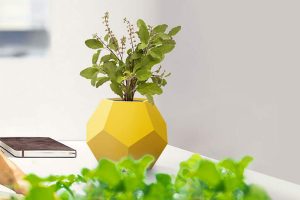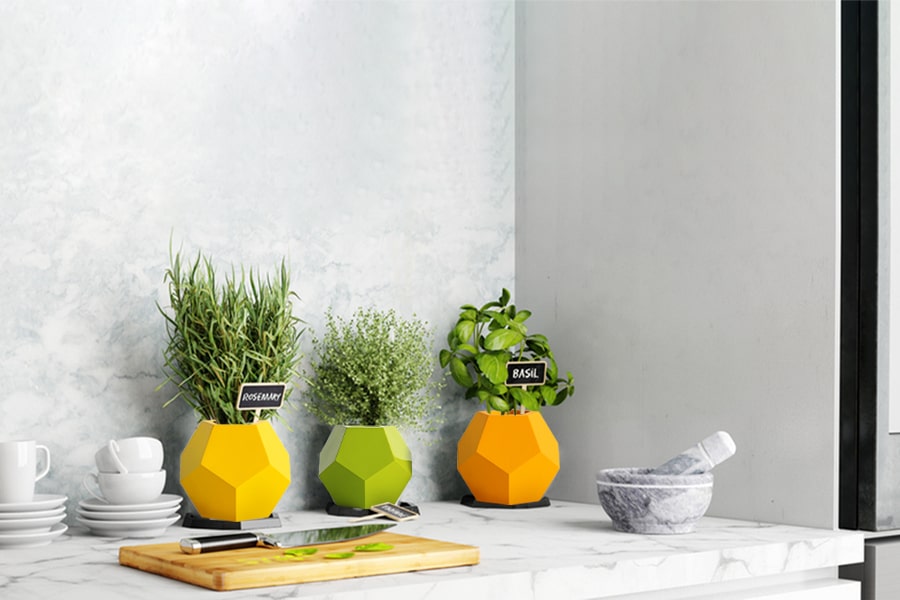Herbs are a natural choice for container gardening or FRP (Fiber Reinforced Plastic) planters, whether you have limited space indoors or simply want something to harvest right outside your door. A majority of herb plants require little in the way of nutrients and care. Not only that, but they continue to grow until the end of the season. Growing your own herb garden is a cost-effective way to enjoy healthy, delicious garden produce with little effort and time.
Adding more to the beauty of your house, herbs look more colourful and vibrant when grown in Fiber Reinforced Plastic (FRP) Planters as these pots come in different shapes, colours, textures and sizes.
Grow herbs in planter boxes
Herbs, unlike many other garden plants, can thrive even in small spaces. Many can grow in poor soil too, with no added fertiliser. Some herbs are also aggressive, meaning they will quickly take over the garden bed and start spreading their roots deeper and wider into the land. Growing herbs in pots or planter boxes keeps them under a fixed periphery and close at hand. This will help you replace the herbs whenever you wish to.
Another major reason for growing herbs in planter boxes is that it adds sophistication and beauty to your decor. There are many people who grow them in indoor-outdoor planters that match perfectly with their home or office furniture.
Planter for herbs
Herbs require varying soil depths, but most will thrive with 6 to 12 inches of root space.
Ceramic, Fiber Reinforced Plastic (FRP) planters and terra cotta pots, as well as planter boxes and raised plant beds made of wood, are ideal for an indoor-outdoor garden. Some herbs may also work well in pots made of pressed paper. Plant boxes made of cedar or redwood are the most durable and resistant to decay, but they are also the most expensive.
The ideal choice is fiber reinforced plastic planters as they are long-lasting, can withstand extreme heat and cold, are easy to clean, stylish and light in weight. The Rezelo Collection by Bonsila comes in 40 different sizes of rectangular planters that are beyond perfect for your herbs. Their wide range of sizes makes them the perfect indoor-outdoor planters.
Soil To Use
Garden soil is too heavy to use in a pot for a container garden or raised bed. The best soil for raised beds, planter boxes, and plant containers is potting mix. Potting soil is light, fluffy, and well-draining, making it ideal for flowering plants, vegetables, and herbs. It’s also ideal for plants that thrive in acidic soil. Adding a bit of peat moss to the potting mix will improve the soil’s ability to retain moisture and texture.
The type of herb you grow will determine the type of growing medium you’ll require. Remember that all herbs planted in containers or boxes require drainage holes, so having one in indoor-outdoor planters is a must!
Herbs in the box
Choosing the right herb is equally important as choosing the best planter for herbs. So what kinds of herbs can you grow in the rectangular box-shaped FRP planters?
Parsley:
A simple plant that grows well in the sun. Italian or flat-leaf parsley and curly parsley are two of the most commonly used varieties in cooking. This herb prefers full sun but can also grow in partial shade. Ideal for indoors with maximum sun exposure.
Mint:
Mint thrives in a variety of growing conditions and is often used to add a zesty freshness to desserts and drinks. It requires little care and looks stunning as a decorative plant. It prefers sun yet can also tolerate shade. Some mint varieties are low spreaders, while others are tall and leggy, so pick the combination that works best for your space.
Oregano:
Oregano is one of the easiest herbs to grow in FRP planters. Like most herbs, it prefers full sun but can tolerate some shade. It does not necessitate a lot of watering or fertilising. It spreads well and will not take over the entire area. It can be grown in a cool place over the winter or propagated from cuttings.
View this post on Instagram
Basil:
A herb garden would be incomplete without it. Basil, a kitchen staple, grows almost effortlessly from seed. It thrives on neglect and prefers infrequent watering over regular watering. Basil despises confined spaces, so give it plenty of room for proper air circulation.

Dill:
A tall, willowy herb that grows quickly from seed. Dill grows best in full sun and prefers rich, lightweight, well-drained soil. It complements a variety of plants and attracts beneficial garden critters such as pollinators.
Thyme:
An aromatic herb that blends well with other herbs. Thyme is an essential ingredient in holiday cooking, so keep a fresh supply on hand. This woody perennial thrives in arid conditions. Thyme does not grow large or spread quickly, so it works well in a container garden.
Sage:
They are beautiful, fragrant, and easy to grow. Sage, like many herbs, does not require heavy feeding or frequent fertiliser application. In fact, too much fertiliser will dull the potent flavour. Sage thrives in full sun, and its foliage is particularly eye-catching when combined with other potted herbs.
Most of these herbs are hardy and drought-tolerant, and they can grow in poor soil. They don’t need much fertiliser and can handle some shade. Preventing root rot requires proper drainage. Once you’ve decided on which herbs to grow, simply place them in a location that receives at least eight hours of direct sunlight per day and water them as needed. It’s also best to avoid using fertilizers; most herbs produce the most fragrance and flavour when grown in raw soil. Use designer planters to add a touch of perfection to your decor.
Bonasila planters offer elegant-looking, unbreakable, eye-catching FRP planters that will add on to the aesthetics and sophistication, making your space more presentable and lively. Be it planters for herbs or anything else, planters by Bonasila are created with love and keeping all the details in mind. These planters with their beauty will blend in and stand out everywhere. Get in touch with us to select the best planter for your favourite herbs!
